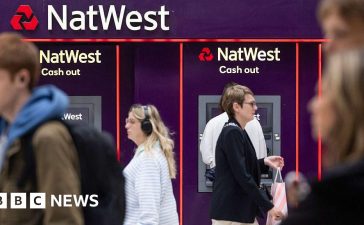
© Reuters. UK pound coins plunge into water in this illustration picture, October 26, 2017. REUTERS/Dado Ruvic/Illustration/File photo
(Removes extraneous material in paragraph 14)
By Harry Robertson
LONDON (Reuters) -British bonds were on track for their best day in more than a month on Thursday and stocks jumped after the Bank of England held interest rates steady for a second consecutive meeting.
Bonds and stocks were already trading higher after the Federal Reserve kept interest rates on hold on Wednesday, with the BoE decision adding to a feeling among investors that the next move in borrowing costs will be down.
Yields on benchmark 10-year UK bonds, known as Gilts, fell as low as 4.318% and were last 12 basis points (bps) lower on the day at 4.381%, down around 2 bps from before the BoE decision.
The drop put the yield on track for its biggest one-day fall since mid-September. Yields fall as prices rise and vice versa.
The BoE left borrowing costs unchanged at 5.25% and published forecasts which showed the British economy was likely to skirt close to a recession and flat-line in the coming years.
A fall in global bond yields boosted stocks, with 100 stock index last up 1.54%. The index was 1.2% higher before the BoE decision.
Smaller companies, which are more sensitive to changes in borrowing rates, outperformed their bigger peers, with the UK’s up 3.15%.
“The news over the last day, from both the Fed and the BoE, indicates that we are done with rate increases, and that decreases are the next item on the agenda,” said Michael Field, the Europe market strategist at Morningstar. “With this in mind, bond markets once again adjusted.”
Yet Field said Thursday’s rally in bonds only went some way to undoing the sharp sell-off that has pushed yields to around their highest level in decades.
The BoE’s Monetary Policy Committee (MPC) voted 6-3 to keep the Bank Rate on hold, in line with economists’ expectations in a Reuters poll.
climbed after the decision but later gave up some gains and was last up 0.24% at $1.2179, as the fall in U.S. yields was weighing on the dollar. It traded around 0.35% higher before the decision.
“The momentum in the economy and future indicators point to lower activity,” said James Lynch, fixed income investment manager at Aegon Asset Management. “The question should now be when will the BoE cut.”
Traders in derivatives markets on Thursday briefly moved to fully price in a BoE rate cut in August 2024, although later dialled that bet back slightly. They see two rate cuts by the end of next year, according to LSEG data.
Ed Hutchings, head of rates at Aviva (LON:) Investors, said: “Medium-term … with weaker growth and past hikes yet to feed through, we are close to all but done with interest rate hikes, which is ultimately supportive for Gilts.”
Britain’s 2-year gilt yield traded 7 bps lower at 4.723%, after hitting its lowest level since June 2023 at 4.655% after the BoE announcement.
Global bond yields have pushed higher over the last two months, driven by strong U.S. economic data, sending the 10-year Treasury yield above 5% last week for the first time since 2007.
Yet that yield – which sets the tone for borrowing costs around the world – was last down 12 bps on Thursday at 4.657%.
Before the U.S. central bank’s policy decision on Wednesday, the U.S. Treasury said it would slow the pace of increases in its longer-dated debt auctions in the next three months.
Adding momentum to the fall in bond yields on Thursday was data showing U.S. weekly jobless claims rose moderately last week.









